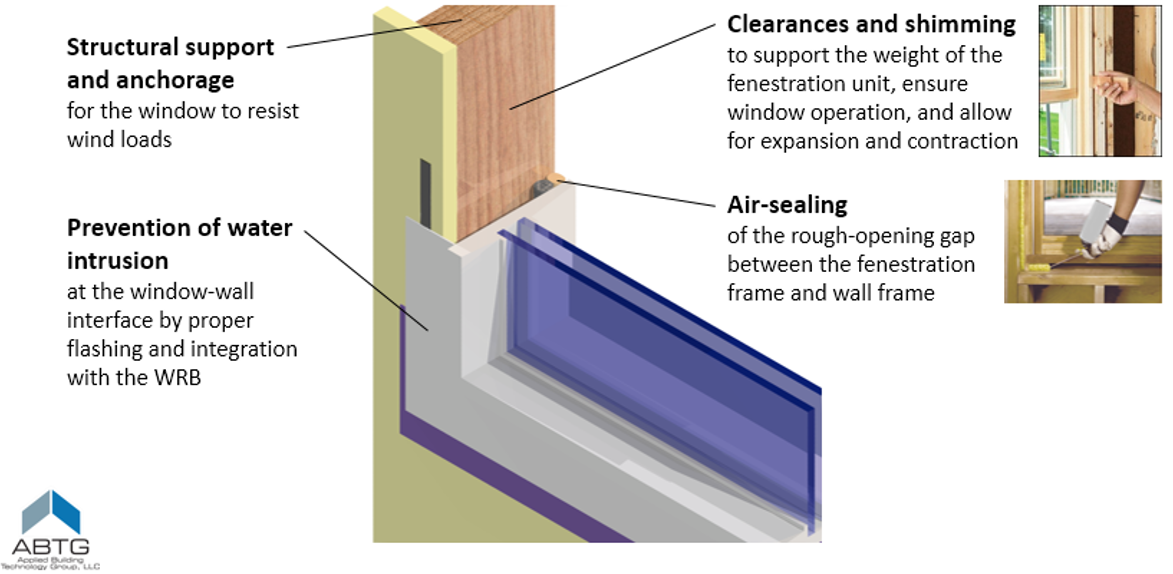The Applied Building Technology Group (ABTG) has completed an education presentation on best practices associated with the installation of pan-flashing and air sealing windows to prevent water intrusion.
This PowerPoint is aimed at keeping walls from getting wet, which is the primary problem with any wall system that has an amount of drying potential (ability to dry out after being wetted). Assuming that walls get wet and hoping that they will dry fast to avoid water damage is not a good installation practice. Conversely, using pan flashing and air sealing is a proven way to keep walls from getting wet at their most vulnerable areas around window and door openings.

As the presentation notes, pan flashing addresses the problems that windows tend to leak (or will leak over time) and air-sealing around the interior of the window in the rough opening gap allows wind pressure to equalize in the gap such that wind-driven rain is not driven into or through the window frame or its interface with the wall. Pan flashing also helps water to drain to the outside, not allowing it to be forced back in by wind pressure. In addition, air sealing is a requirement of the energy code to properly interface a walls’ air-barrier with the window/door unit.
View and share this presentation to raise awareness of the multiple benefits to these practices.
This PowerPoint and its recommendations are based on extensive study of a number of earlier publications:
- “Window Sill Details for Effective Drainage of Water”, 2011 (http://www.nrc-cnrc.gc.ca/ctu-sc/ctu_sc_n76)
- “Window Installation Details for Effective Sealing Practice”, 2013 (http://www.nrc-cnrc.gc.ca/ctu-sc/ctu_sc_n80)
- “Water Penetration Resistance of Windows – Study of Manufacturing, Building Design, Installation and Maintenance Factors”, CMHC-SCHL Canada, Research Highlight Technical Series 03-124, November 2003 (https://www.cmhc-schl.gc.ca/odpub/pdf/63367.pdf)
- “Water Penetration Resistance of Windows – Study of Codes, Standards, Testing and Certification”, CHMC-SCHL Canada, Research Highlights Technical Series 03-125 (https://www.cmhc-schl.gc.ca/publications/en/rh-pr/tech/03-125-e.htm)
- “Water Penetration Resistance of Windows – Study of Manufacturing, Building Design, Installation, and Maintenance Factors”, RDH Building Engineering Limited, Vancouver, BC, Canada (study sponsored by Canada Mortgage and Housing Corporation, Homeowner Protection Office, and British Columbia Housing Management Commission) (http://rdh.com/wp-content/uploads/2014/07/Water-Penetration-Resistance-of-Windows-Study.pdf), December 31, 2002.
- “Water Penetration Resistance of Windows – Study of Codes, Standards, Testing, and Certification”, RDH Building Engineering Limited, Vancouver, BC, Canada (study sponsored by Canada Mortgage and Housing Corporation, Homeowner Protection Office, and British Columbia Housing Management Commission) (http://rdh.com/wp-content/uploads/2014/07/Water-Penetration-Resistance-of-Windows-Study.pdf), December 31, 2002.
- “Results of Assessing the Effectiveness of Wall-Window Interface Details to Manage Rainwater”, 11th Canadian Conference on Building Science and Technology, 2007 (http://www.nbec.net/documents/RESULTSONASSESSINGTHEEFFECTIVENESSOFWALL-WINDOWINTERFACEDETAILSTOMANAGERAINWATER-M.A.LACASSE.pdf)